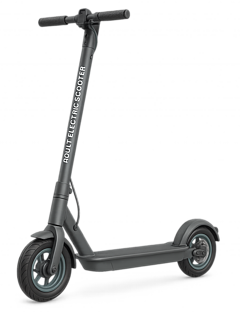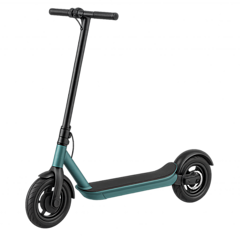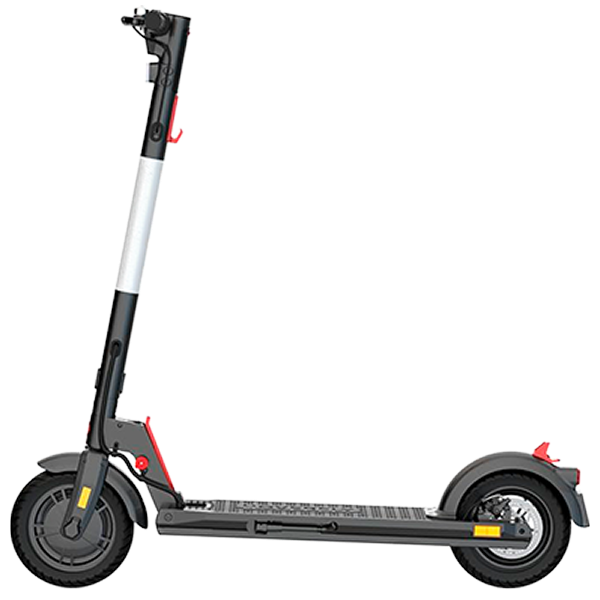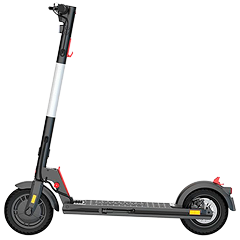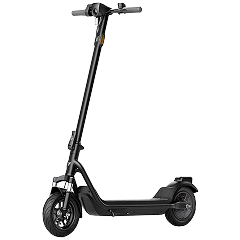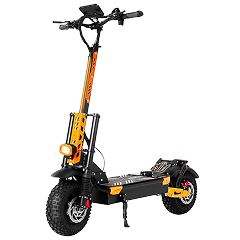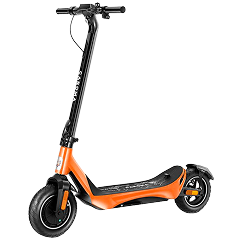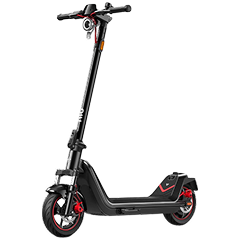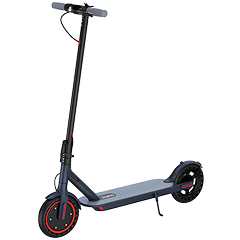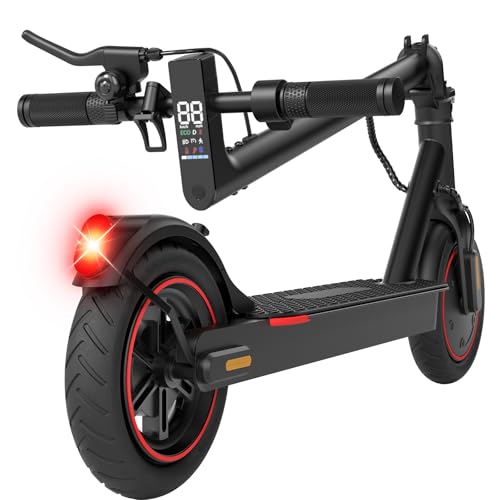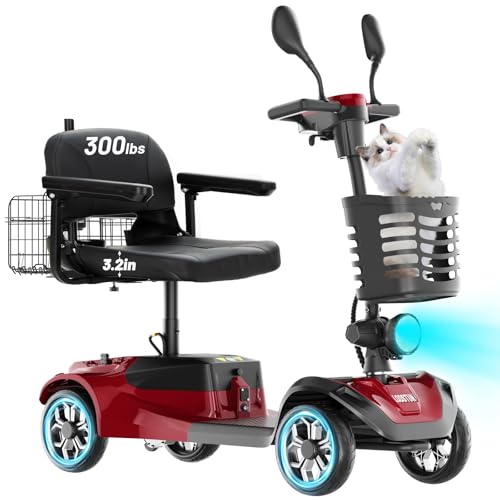Buying an electric scooter is difficult at the moment. Manufacturers have seen that there’s demand for electric scooters, and now there are tens of manufacturers popping up every day. Most are just slapping their logo on the same generic frames rolling out of the same factories. I’ve seen the exact same scooter sold as a different brand. Same specs, same frame, but different price ranges depending on how fancy the website looks. Manufacturers also inflate their statistics so they can seem better.
They know speed, power and range are what you check first, so those numbers get the creative treatment. But deep down, there are some numbers and features you can check to give you a real indication of their claims.
So in this guide, we’ll give you some of the cheat sheet numbers and features, and what you should look for when buying your electric scooter to avoid being left stranded or broke. Or both. Wherever possible, we back up claims with test data so you get an honest picture of what you’re buying.
What Should You Look For When Buying an Electric Scooter?
The ultimate decider of what you get rests on the amount of money you have. If you have anything above $500, you can get at least a decent entry-level commuter. Higher than $1000, and you can get at least a performance scooter. But even with a limited budget, these are the things you should look for in an electric scooter:
Performance
More specifically, this includes:
Range
This is how far you can go on the electric scooter on a single full battery charge. One important piece of advice though, never rely on what the manufacturer states as the range, since their range tests are usually conducted under ideal conditions that are hard to replicate in real life. So that “40-mile range”? That’s tested with a 165-pound rider going 12 mph on perfectly flat ground under ideal conditions. In the real world, you’ll get 60% of that if you’re lucky.
These published ranges typically come in about 20% higher than real-world test results on average, and for scooters that really push their claims, the gap stretches to roughly 40%. So, to get a more accurate idea of the range you’ll get, look at the battery capacity, battery manufacturer, and battery type.
In theory, range scales almost linearly with battery capacity, measured in watt-hours (Wh). Doubling your battery capacity roughly doubles your distance (assuming all else is equal).
A larger battery capacity generally means the scooter can travel farther and handle higher power draw for longer, with less performance drop as the battery depletes.
Just to give you an overview, this is how capacity roughly correlates with range:
- ≤ 200 Wh: Found in very short-range scooters and basic last-mile commuters. For example, a 36 V × 4.4 Ah (158 Wh) might claim 10-15 miles but will likely get 8-11 miles in practice.
- 200-500 Wh: Entry-level commuter range. These scooters typically claim 15-25 miles but deliver 12-18 miles in real-world conditions. Good for short commutes and last-mile solutions.
- 500-1000 Wh: The sweet spot for most riders. Claims of 25-40 miles usually translate to 18-25 miles actual range. Sufficient for most daily commutes with some buffer.
- ≥ 2500 Wh: Extremely high capacity. Scooters with 2500-3000+ Wh are often ultra-performance models . They might claim 80-100 miles, though real-world may be 55-70 miles at reasonable speed.
So roughly speaking, each 100 Wh buys you 2-3 miles on average, depending on efficiency.
So roughly speaking, each 100 Wh buys you 3-5 miles on average, depending on efficiency. However in practice, it’s important to note that real-world range depends on rider weight, terrain, riding speed, and weather.
For battery type, lithium over lead-acid batteries anytime, as they weigh less, deliver steadier power, recharge faster, and last far longer. For battery manufacturers, big-name cells (LG, Samsung, Panasonic) tend to hold up better than no-name batteries.
So to be safe on range, just look at the distance you cover every day round trip, add in a few miles for the occasional detour (20-30% above your need), then compare that to whatever the manufacturer claims multiplied by 0.6. If it fits, you’re good to go. If your commute is 8 miles, get a scooter rated for more than 12 miles of actual range (which might mean around 20 miles on paper).
Verdict: Battery capacity is a better indicator of range. Higher watt-hours = better range if other factors remain constant. Take 60% of the manufacturer’s claimed range to get a realistic value. To get an average of 20 miles, aim for a battery capacity of more than 500Wh.
Speed and Acceleration
Speed and acceleration are other metrics most riders go for, but as a new rider, you shouldn’t be overenthusiastic about it. The design of scooters limits them from being safe at high speeds since those tiny wheels weren’t designed for 40 mph, especially if you’re not an intermediate to expert rider.
That said, you still don’t want an excessively slow scooter that gets passed by joggers. Something in the 13-20 mph range should work for most beginner riders; quick enough to keep up with bike lane traffic without pushing your luck.
Again, manufacturers know that this is another area most riders check, so the numbers, though not as inflated as range, usually involve some creative accounting. That’s because manufacturers test speed with:
- A fully charged battery (first 10% of ride only)
- Perfect flat ground
- No wind
- Fresh-from-factory components (pre-bearing wear)
You’ll be riding with:
- A partially charged battery
- Real roads (hills, cracks)
- Wind (and it’s always a headwind—Murphy’s Law)
- Components with some miles on them (bearings wear, belts stretch)
So for a clearer picture, check the motor power, controller limits, and battery voltage/current. All three work as a single chain, and the weakest link sets the limit.
As a rule of thumb, more motor watts means higher speed and snappier off-the-line punch. A 500-700W single-motor scooter typically tops out around 20-30 mph in real-world tests, which is good for keeping pace in bike lanes without pushing chassis stability limits. On the higher end, a 2000W electric scooter will reach speeds of 35+ mph. Higher wattage also means the motor can safely handle more current before overheating, providing stronger acceleration.
Here’s a table to give you a rough idea of the relation between motor power and speed:
Adequate current from the battery keeps torque high during hard launches; weak or half-empty battery packs sag, and the scooter slows down. Larger Wh capacity lets the pack hold its voltage longer, sustaining acceleration deep into the ride.
The controller is the “throttle brain,” translating your throttle input into an amp (current) command to the motor. In other words, the controller caps how much current goes to the motor. A good controller will allow full current flow for fast starts. If the controller is underrated, the scooter may feel gutless at launch.
For controller types, there are two main options: sine wave and square wave controllers.
Sine wave controllers offer smoother throttle response, quieter motor operation, better low-speed efficiency, and are gentler on the drivetrain, making them ideal for commuters.
Square wave controllers offer sharper initial punch and are cheaper, but they’re noisier and less efficient, and can feel jerky at low speeds. They’re favored in budget or stunt builds.
Lastly, consider your local laws: many places cap e-scooters at 15–20 mph on city streets, so a 40 mph scooter might be “too much” for your daily commute. But if you want room for off-road use or just extra power reserve, a higher top speed is still nice to have.
Note: Rider weight, tire size, wind, gradients, terrain, and even firmware speed caps can all knock a few mph or seconds off spec sheet claims.
Verdict: To get a speed of around 20mph, which is the sweet spot for most commutes, don’t go below a 500W motor. With that setup, you’ll also get acceleration of around 5 seconds to 15 mph.
Hill Climbing
For hill climbing, just like with speed and acceleration, it depends on the same three factors: motor, battery, and controller limits. Larger parameters mean better climbing ability.
Torque is what overcomes gravity on a slope. A higher continuous wattage on the motor correlates with higher torque, which equals more sustained hill-climbing ability without thermal cut-out.
In addition, a dual-motor scooter is preferred. Two motors (front and rear) double the torque applied to the ground and share the thermal load, preventing motor over-temperature shutdowns. Also, dual motors almost always out-climb a single motor of the same total wattage because each wheel has full traction and less slip.
To get a good climber, aim for a scooter that has a total rating of around 1000W and is dual-motor. Any scooter under 500W will struggle on very steep hills with an adult on board. 250W single motor? What hills? You’re walking.
Verdict: A 500W scooter will handle moderate hills (10%). For a great hill climber, try to keep the minimum at 1000W, dual-motor preferably.
Braking Performance
For braking, you have stomp brakes, electronic brakes, drum brakes, and disc brakes arranged in order of hierarchy, with stomp brakes being the weakest and disc brakes the strongest.
You also need redundancy in your braking system. An electric scooter with two braking configurations will be preferred over one with a single braking system, because when one stops working, you want options.
To give you a perspective of the braking distance based on the braking system used:
Verdict: A scooter with two different brake setups minimum: regen brake + mechanical brake (disc preferred).
Portability
Portability involves two primary aspects:
Weight
This is the scooter’s weight, and it’s crucial, especially if you need to carry or lift the scooter frequently (up stairs, into a car, onto public transit). A lighter scooter is easier to handle, more portable, and generally more convenient for last-mile use.
Heavy scooters, while often having better performance due to bigger batteries and motors, can be a burden to transport when not riding.
To put this in perspective, ultralight electric scooters weighing 20 lbs or less feel about the same as a kick scooter with a small battery. You can lift them with one hand, maximizing portability, though you’ll typically sacrifice power or range. However, these are rare.
Most “portable” commuter scooters fall between 21 and 40 lbs. This range offers a good balance of performance and portability, though as you approach the 40-lb mark, you’ll start noticing the weight during longer carries.
Beyond this, high-performance scooters with big batteries and motors often reach 60–100+ lbs. At this point, they’re essentially furniture that occasionally moves.
As a rule of thumb, aim for a scooter that’s no more than 20-25% of your body weight. Any heavier and you’ll dread every lift. For example, if you weigh 160 lbs, a 40-lb scooter is about your limit for easy carrying.
Folded Dimensions
The scooter might be lightweight, but imagine if it doesn’t fold? It will still be awkward to carry around or store when not in use, so this is another important aspect. You’ll want a scooter that at minimum folds at the stem to reduce the size. There are some that have folding handlebars that reduce the size further, but the foldable stem is enough in most cases. Those extra folding points are just more places to develop wobbles anyway.
Beyond basic folding, thoughtful design details make a real difference. Built-in carrying handles, shoulder straps, or even small wheels that let the folded scooter roll like a suitcase can transform your daily experience. If you frequently use public transit or need to fold and unfold regularly, prioritize features like one-click folding mechanisms and sturdy latches that won’t leave you wrestling with your scooter.
Verdict: If you will be carrying your electric scooter a lot, try to keep the weight under 40 lbs. It should be foldable, and a carrying mechanism can be an added advantage.
Ride Quality, Comfort and Handling
This is definitely not a stronghold for scooters due to their limitations, but some scooters certainly suck less than others due to several key factors:
Tire Type
We have three main types: pneumatic (air-filled, can be tube-type or tubeless), solid (airless) tires, and some hybrid variants (honeycomb, foam-filled, or one pneumatic plus one solid tire on the same scooter).
When it comes to performance, pneumatic (air-filled) tires are the preferred choice—that’s why most performance scooters use them.
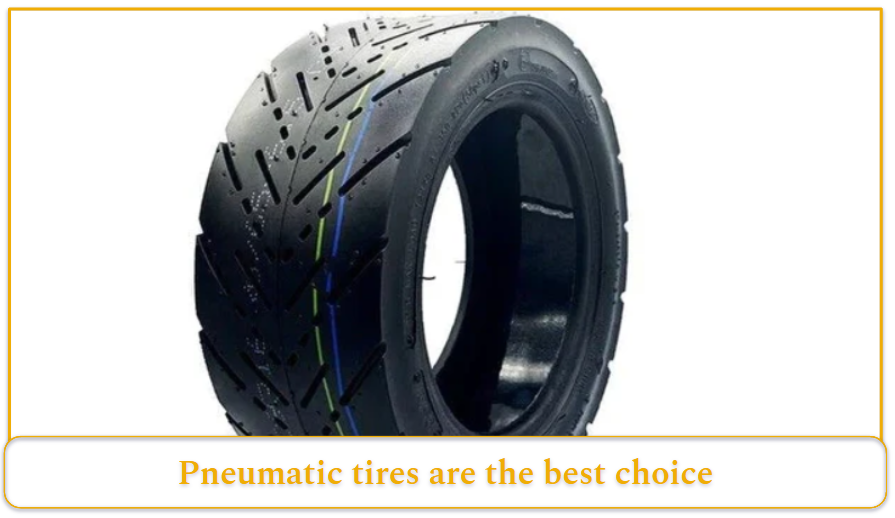
Pneumatic tires, especially when properly inflated, act as secondary suspension. They absorb shocks and provide better traction, especially on wet or slippery surfaces. The tire can conform to the road and usually comes with tread suitable for varied conditions. The downside is they can puncture, requiring regular pressure checks and the occasional flat repair.
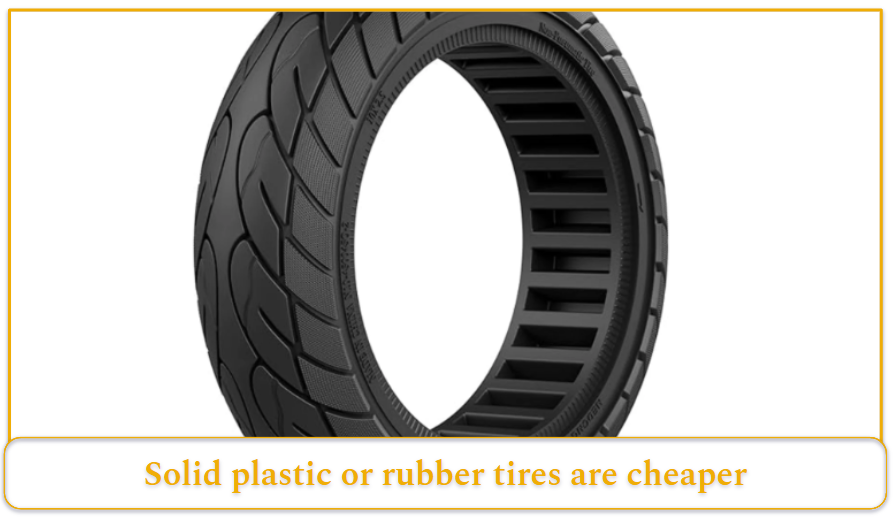
Solid rubber or plastic tires, on the other hand, are mostly found on budget electric scooters as they’re cheaper to produce. They never go flat, which is a huge convenience, but they transmit every vibration to the rider and the scooter’s frame. They often have less grip on wet terrain and can skid more easily. Essentially, this is the lowest tier for comfort and grip.
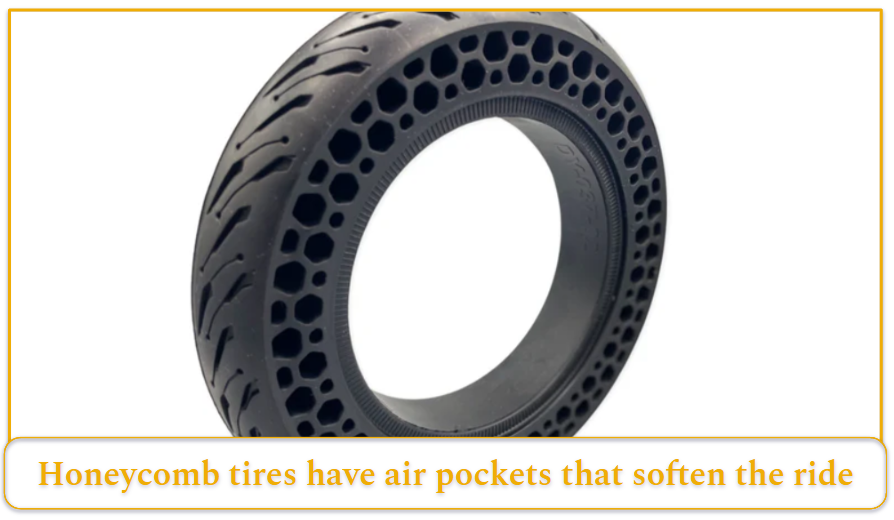
Hybrid designs attempt to offer a middle ground. For example, honeycomb solids have air pockets to soften the ride, or a scooter might use a pneumatic front tire (for shock absorption) and a solid rear tire (for durability). These solutions aim to reduce drawbacks by trying to give the ride quality of pneumatics (which they fall short of) and the maintenance-free quality of solid tires (which they imitate very well).
Tire type involves a trade-off between comfort/handling (pneumatics win) and maintenance-free operation (solids win).
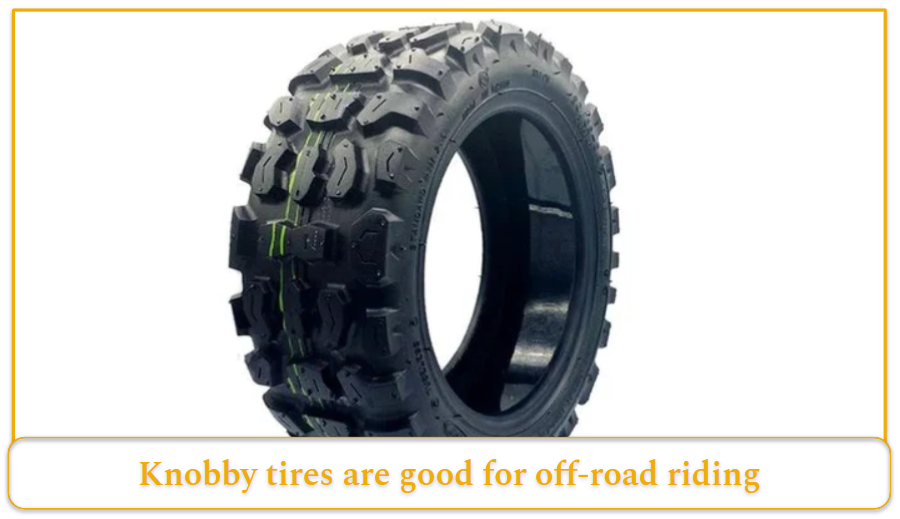
We also have tire tread patterns—for city riding you’ll want street tires with minimal tread, and for off-road you’ll want knobby tire patterns. However, knobby tires on streets will feel less stable and be very noisy (sounds like you’re riding a very angry bee).
Tire Size
For tire size, the bigger and wider, the better for ride quality. However, increasing tire size beyond a point yields diminishing returns and comes with trade-offs in weight and portability (huge wheels make the scooter bulkier). But we’ll concentrate on the ride quality as the tire size won’t affect portability that much unless you have a 16″ tire, which can be a bit of a hindrance.
Larger wheel diameters generally mean the scooter can roll over bumps and potholes more easily, reducing the chance of a fall from a small obstacle. A bigger tire also improves stability at speed (longer contact patch and higher rotational inertia).
Most scooters use wheel diameters in the 8-11 inch range, which is a compromise between portability and ride quality but is usually sufficient for paved riding. 10-inch tires are considered a gold standard for modern commuter and performance scooters.
Some electric scooters on the other end of the scale use wheels larger than 15 inches in diameter. At this point, you’re using bicycle-sized wheels, which provide the best ride smoothness and obstacle clearance. These are uncommon in stand-up scooters and often feature seated designs or unique configurations.
Suspension (Shock Absorption Systems)
Initially, most electric scooters didn’t have suspension, but in today’s market, most have some form of it. That’s because suspension is quite important for ride comfort and safety. Electric scooters have small wheels and can be jarring on rough surfaces; good suspension (springs, shocks) dramatically improves ride quality by absorbing bumps.
Not only that, it also helps with control and stability. Hitting bumps or potholes without suspension can cause the scooter to lose traction or the rider to lose control. Suspension keeps the wheels in contact with the ground when going over uneven terrain, maintaining stability and braking effectiveness. It also reduces stress on the frame and electronics by dampening vibration, prolonging the scooter’s lifespan.
As I often say, unless you only ride on perfectly smooth roads, suspension is almost a must-have.
Scooters under $500 typically offer minimal to no suspension, featuring only small rubber blocks or rudimentary spring pistons with negligible travel. This basic setup results in a harsh ride on rough surfaces, making them unsuitable for daily urban use where road imperfections are common.
Electric scooters in the $500–$900 category step up with single spring suspension, either at the front fork or rear shock. While this basic suspension system improves ride comfort over minor bumps compared to budget options, it lacks the comprehensive coverage of dual suspension. The result is a noticeably better experience than budget scooters, making them suitable for light urban commuting.
Electric scooters in the $900–$1,600 range feature either dual spring suspension with stiff coil springs or basic hydraulic shocks. This dual suspension setup provides improved shock absorption over moderate bumps and delivers solid performance on city streets with occasional rough patches. These systems can also handle light off-roading adequately, offering a good balance of comfort and capability for most riders.
High-end scooters utilize advanced hydraulic or air shocks, often with adjustable settings for preload or damping. These sophisticated systems provide superior bump absorption and damping control, resulting in excellent comfort and control over varied terrain. They minimize jarring impacts and maintain stability even at higher speeds.
Again, don’t expect motorcycle or e-bike type suspension performance from electric scooters, they still have their limitations.
Deck Size
This is basically where you stand on a scooter, so it should be large enough to fit both your feet comfortably, either side by side or one in front of the other like on a skateboard. You should have enough space to shift your feet during steering and enough grip to stay securely planted.
A wide, long deck (22 inches long and 8.5 inches wide) gives your feet enough space to move around, though most scooters typically have a deck size of around 19×7.5 inches on average, which still provides good spacing and will fit most foot sizes.
I’m a size 11 (US) and find that a deck size of 20×9 inches like on the Kaabo Wolf King GT works well for me.
Fortunately, if you have small feet, most electric scooter decks will accommodate you comfortably. As for grip, decks can be lined with different materials: grip tape (skateboard-style abrasive), molded or textured rubber mats, and silicone inlays with raised patterns to keep your shoes planted and provide the necessary traction.
Handlebar Width and Height
This mainly affects taller riders. You don’t want to be hunched over on an electric scooter throughout the journey, so look for an electric scooter whose handlebar height matches your height.
I’m 6 feet 1 inch, and a bar height of about 40 inches feels natural. Riders 6′ and taller do well with bars in the 39-42″ range—anything less and you’re cosplaying as Quasimodo. If you’re between 5′ and 5’9″, the typical scooter bar (36-38″ high) will already sit at a comfortable chest-to-waist level.
For handlebar width, most electric scooters come with narrow ones around 16-22″. If you’re choosing between options, always go for the wider one. A wider bar gives your arms more leverage, making sudden direction changes smoother and high-speed runs steadier. Bars narrower than your shoulder span tuck your elbows in, which can feel cramped on long rides.
Verdict: If you’re looking for comfort: pneumatic tires are the way to go (accept the flat tire risk), wheel size around 10″, dual springs at minimum, a wide and long deck around 19″×7.5″, and handlebar height based on your height.
Safety Features
For safety, the two most important things to look at are mainly lighting and braking (which we’ve covered already).
Lighting
It’s not advisable to ride an electric scooter, especially one without any lighting features, at night. But there are some unavoidable conditions that may require you to, so for that, you need to have an electric scooter that at least has a basic lighting system. Good lighting ensures the rider can see the path and, more importantly, be seen by others.
This includes headlights, taillights (especially brake lights), turn signals, and any ambient or side lighting (deck lights, stem lights) that improves visibility.
The bad thing is that many scooters come with only basic lights, which may be dim or positioned low to the ground, making them less effective.
But at the bare minimum, your scooter should have:
- A bright headlight well-positioned at rider height for distance illumination—400 lumens works for lit streets. If you’re riding anywhere rural where there’s not much ambient light, then 800 to 1200 lumens.
- Rear lights that are bright and flash on braking
- A number of reflectors all over the scooter
As you go up the ladder, you get additional lighting systems like integrated deck lights for ambient lighting. While sometimes just for show, they actually improve side visibility, which is important at crossings or if a car is entering from a side street. Premium scooters may also feature turn signals similar to motorcycles and headlights with higher lumen output or even dual headlight configurations.
Additional Safety Features
Electric scooters are borrowing a lot from motorcycles, and high-end scooters do come with technology that motorcycles have been using for rider safety. This includes things like brakes with ABS, which prevents wheel lock-up during hard braking and reduces chances of losing control.
We also have traction control in some scooters. Due to the small tires on scooters and massive power from the motors, traction control helps minimize wheel spin and loss of control.
We also have other features like:
- App-based motor locks, which lock the scooter and freeze the motor (via app), adding rolling resistance that makes pushing the scooter away difficult.
- Immobilizer modules that cut power to the controller and trigger a loud siren when the scooter is lifted or shaken, giving you time to react.
To be honest, while these features do help in deterring thieves by drawing attention and discouraging a quick getaway, the fact remains that most electric scooters are small and pretty easy to carry, so they aren’t your best line of defense against theft. A determined thief can just pick it up and try to make off with it, especially if it’s in a less crowded area. Your best security is still a proper U-lock and never letting it out of sight.
For added security, some come with GPS trackers that send real-time location to your phone and raise a push alert if the scooter is touched when locked. You can then use the live pin to recover your stolen ride.
However, these are just add-ons and they really shouldn’t affect the scooter you pick. Though admittedly, it’s pretty cool to have them. And like airbags in cars, you hope you never need them, but when you do, you’ll be really glad they’re there.
Verdict: At the very least, have basic lighting: a 400 lumen headlight and a rear taillight that doubles as a brake light. And of course, a good braking system. Then maybe a GPS tracker or AirTag somewhere hidden.
Build Quality, Durability and Reliability
Build quality is fairly straightforward to establish—you can just look at the scooter and tell if it’s well-built. No flimsy plastics, no assembly that looks like it was done by someone having a bad day, and definitely no substandard welded joints.
For durability and reliability, it’s harder to determine because this will vary based on how you ride, where you ride, and your maintenance practices. That’s why you’ll hear about even the best scooters having problems here and there. Also, you’ll need to live with a scooter for at least a year to form an honest opinion about its long-term performance.
For immediate assessment, community reports and user reviews provide the most reliable insights.
But just to have a rough idea, you can look at factors like:
Material, Finish and Design
Most electric scooters use 6061 aluminum for their frame construction, which works fairly well—it’s light, strong enough, and doesn’t rust. But that doesn’t mean it’s the only material that can be used. You can also get electric scooters made of steel (heavy but sturdy), and other innovative materials like magnesium alloy in the UNAGI (fancy and light), and some that use carbon fiber (for when you need your scooter to cost more than a used car). All of these materials can work effectively in electric scooter construction when properly implemented.
When examining a scooter, pay close attention to visible welds. Smooth, evenly ground welds indicate quality manufacturing, while sharp edges or rough weld beads can develop cracks under stress.
Since cracked stems and wobbling are among the most common catastrophic failures, examine these mechanisms closely and look for reinforcement features. A double-locking or through-bolt latch made from 6061-T6 aluminum (or featuring a steel pin) significantly reduces these risks.
Finally, avoid electric scooters with excessive flimsy plastic components, as these represent potential failure points that can compromise safety and longevity.
Rider Weight Capacity
This specification determines the maximum rider weight the scooter can support without experiencing performance degradation or safety issues such as frame damage, reduced speed and power, or compromised braking effectiveness.
It’s not a magic indicator, but a scooter with a higher rider weight capacity does add confidence that the scooter is strongly built.
Most electric scooters have a rider weight capacity of around 220 lbs, with a few crossing into the 300 lbs territory. These higher-capacity scooters usually have reinforced frames, stronger motors, and other parts that can handle the extra load.
So, try not to go for anything lower than 220 lbs capacity—even if you weigh 150 lbs, that extra margin means the scooter isn’t stressed at capacity. Plus, the weight of your groceries and backpack adds up.
IP Rating
IP rating is the standard that measures how well the chassis, seals, charge-port caps, and gaskets keep out dust (first digit) and water (second digit) — the two things that love to destroy electrical components.
A higher IP rating significantly reduces the risk of damage when riding in wet or dusty conditions, while a lower rating means increased vulnerability to these environmental factors.
Although riding in rain isn’t recommended, unexpected weather can catch you off guard, making water protection essential. Avoid electric scooters with no IP rating, as they offer no certified protection against water intrusion and remain highly susceptible to damage from rain or splashes.
Luckily, most electric scooters have an IPX4 rating, which should be the minimum you’re looking for. This provides protection against light rain or road spray from any direction, though it lacks dust certification.
On the higher end, we have IP67 electric scooters (dust-tight + temporary immersion). These can survive brief immersion in water (up to 30 minutes at 1m depth) in addition to being dust-tight. However, they’re rare.
Note: Even at this protection level, extended or deep submersion should be avoided, as no scooter is truly “waterproof.”
Warranty Length & Coverage
Judge the warranty by how long it lasts and what it covers. A longer, more comprehensive warranty demonstrates the manufacturer’s confidence in their product quality while protecting you from early defects or failures, potentially saving significant repair costs.
E-scooters have many components that can malfunction, especially the electronic bits (battery, motor, controller, etc.), and repairs can be costly. A motor replacement can cost more than some entire budget scooters.
Most scooters include 6-12 month warranties, with a full year considered a solid baseline. For coverage, look for one that covers at least the major components — motor, battery, controller, and frame.
Research the scooter’s community forums to verify whether manufacturers honor warranty claims consistently. If half the posts are “warranty denied” stories, that’s your red flag parade.
Avoid anything without a warranty—it shows the manufacturer has less faith in their product than you should. Even a 90-day warranty (common for budget models) is preferable to no coverage, though three months essentially covers only early manufacturing defects.
Battery Quality & Safety
Branded battery cells from manufacturers like LG, Samsung, and Panasonic consistently outperform generic alternatives, lasting hundreds more charge cycles.
When possible, verify whether the scooter or battery pack carries relevant safety certifications (such as UL certification in the United States). UL2271 (for batteries) or UL2272 (for complete scooters) stickers indicate the product passed specific safety standards, including crush, drop, and thermal-runaway tests. While certifications don’t guarantee perfect quality, they suggest basic safety oversight during manufacturing.
Additionally, look for scooters that clearly advertise a Battery Management System (BMS) that protects against overcharge and over-discharge conditions and helps protect overall battery health.
Brand Track Record
Not to dismiss generic brands—they’ve recently started producing scooters that don’t immediately fall apart. But if you want to err on the side of caution, you’re better off going with established brands like Segway, GOTRAX, Inokim, NAMI, Kaabo, etc. They’ve been around long enough to work out the obvious kinks and typically offer better long-term support.
The advantage of these established brands isn’t just quality, it’s the entire ecosystem. Forums full of owners, YouTube reviews, known issues and fixes, and parts availability. But all this means brand names will obviously cost you more.
Serviceability & Parts Availability
You want an electric scooter that has readily available parts and can be serviced either by yourself or at local shops. Check if the manufacturer sells replacement parts directly—tires, tubes, brake pads, and common failure items should be available. This consideration becomes crucial for long-term ownership and maintenance costs.
Verdict: Look for solid construction (good welds, minimal plastic), 220+ lbs weight capacity, IPX4 rating minimum, at least 6-month warranty covering major components, branded battery cells with BMS, established brand or strong community support, and available replacement parts.
What Electric Scooter Should You Buy?
Now, based on the details we have above, different scooters suit different needs, so I’ll try to create a small cheat sheet that you can use.
The Perfect Commuter Electric Scooter
If I were a commuter who used an electric scooter daily and needed to use multimodal transport, I would look for an electric scooter with these properties:
- 500-700W motor (single is fine for flat terrain, bump to 1000W dual if your commute is hilly)
- 500–800 Wh battery for about 18–25 miles of real range (remember the 60% rule)
- Dual braking system (disc + electronic minimum)
- 8.5″-10″ pneumatic tires (solid if you’re allergic to maintenance but hate comfort)
- IPX4 water resistance or better
- Weight between 30-40 lbs
- Bright lights front (400-600 lumens) and rear with brake activation
- Solid folding mechanism with safety latch
- 220+ lbs weight capacity minimum (margin of safety)
- At least 6-month warranty from a brand with actual support
- Price range: $600-1200
This setup will handle 90% of urban commuting. If your budget is under $500:
- Accept 250–350W motor (14–18 mph reality)
- 200-350Wh battery (10–18 miles real range)
- Single rear disc or drum plus electronic
- 8.5″ tires
- Basic or no suspension
Luckily, most of them will weigh around 30 lbs, so they’re very portable and can actually make for good entry-level commuters or last-mile scooters once you know the trade-offs.
Performance/Off-Road Electric Scooter
If I did a lot of off-roading, long distance commuting, or was looking for an electric scooter just for the thrills (and had good insurance), I would aim for:
- Dual 1000-3000W+ total
- 1,500 Wh or larger battery for about 35–50 miles of real range
- Dual hydraulic/mechanical disc brakes (non-negotiable at these speeds)
- Full suspension front and rear with actual hydraulic damping
- 10-11″+ tires with 3″+ width, knobby treads for off-road, street treads for speed
- IP54 rating minimum
- Strong frame with 265 lbs+ weight capacity
- Quality battery cells (LG/Samsung/Panasonic) with robust BMS
- Wide deck (19×7.5 inches minimum)
- 1000+ lumens front, rear/brake lights, deck lights and turn signals if possible
- Reinforced frame and stem (double-locking mechanism mandatory)
- Steel or reinforced aluminum construction over lightweight materials
- Price range: $1500-3000+
Electric Scooter for Heavy and Tall Adults
If I were a heavy and/or tall rider, I would look for an electric scooter with:
- Weight capacity of 265 lbs+
- Dual motor (500W+) for better weight distribution on flat land; on hills you would want something like dual 1,000W
- 700 Wh or larger battery to offset the extra load and still clear 20+ miles
- Reinforced frame and stem (double-locking mechanism mandatory)
- Wide deck (19×7.5 inches minimum)
- Handlebar height (39-42″ range for 6’+ riders)
- Strong suspension with adjustable preload to handle weight without bottoming out
- Dual hydraulic/mechanical disc brakes
- 10-11″+ pneumatic tires, the bigger the better
- Steel or reinforced aluminum construction over lightweight materials
- Price range: $1200-3000
Most performance and off-road electric scooters will fit heavy/tall riders by default. They’re already built tough with high weight capacities, powerful motors, and large batteries. Just check that the handlebar height reaches your comfort zone.
The Bottom Line
So basically, how you plan on using the scooter will determine the type of scooter you want. Take your time to assess your needs honestly — there’s no point buying a performance beast if you’re only going 3 miles to work on flat ground. Similarly, don’t cheap out if you need something that can handle daily 20-mile commutes with hills.
FAQs
What Range Can I Expect From a Fully Charged Scooter?
Take whatever the manufacturer claims and multiply by 0.6 to get a realistic range. Most manufacturers test under ideal conditions, which is hard to replicate in real life. In reality, you’ll get about 60% of the claimed range. For example, a scooter advertised as having “40 miles range” will likely give you 24 miles in real-world conditions.
A better indicator of range will be the battery capacity. Roughly speaking, each 100 Wh gives you 2-3 miles of range. For a reliable 20+ mile range, aim for 700+ Wh battery capacity.
How Much Should I Spend on My First Electric Scooter?
Budget breakdown:
- Under $500: Basic commuters with 250-350W motors, 200-350Wh batteries. Good for short trips (10-18 miles) on flat terrain.
- $500-$1200: The sweet spot for most riders. You get 500-700W motors, 500-800Wh batteries, decent suspension, and real range of 18-25 miles.
- $1200+: Performance scooters with dual motors, longer range, and premium features.
Rule of thumb: If you’re commuting daily and using it as your main transport, try not to go below $600. If it’s just for occasional fun rides or as the last mile commute, $300-500 can work.
How Long Does Charging Take and When Will I Need a New Battery?
Can I Ride My Electric Scooter in the Rain?
Yes, but only as a last resort, as chances of slipping increase a lot. Look for a minimum IPX4 rating, which protects against light rain and road spray. However:
- Avoid puddles and standing water
- Never ride in heavy rain or storms
- Dry your scooter thoroughly after wet rides
- Braking distance increases significantly on wet surfaces
- Slipping chances increase
- Visibility decreases
- You might void the warranty
Even “waterproof” scooters aren’t meant for deep water or prolonged exposure to rain.
What Power Is Needed in an Electric Scooter to Climb Hills?
This depends on the weight of the rider and the size of the incline. The larger these numbers, the more motor power you need. For moderate hills (10% grade), a 500W minimum can try to keep up. For steep hills or heavy riders, 1000W+ dual motors are preferred.
Single motors under 500W will struggle on hills with adult riders. If you weigh over 200 lbs or face steep inclines regularly, budget for at least 1000W total power (often dual 500W motors).
Should I Get Solid or Pneumatic (Air-Filled) Tires?
Pneumatic tires are better for comfort and traction but require maintenance:
- Much smoother ride, better shock absorption
- Superior grip, especially in wet conditions
- Can get flats, need regular pressure checks
Solid tires are maintenance-free but harsh:
- Never go flat, zero maintenance
- Transmit every bump, less comfortable
- Less grip on wet surfaces
Choose pneumatic unless you absolutely can’t deal with potential flats.
How Heavy Is Too Heavy for an Electric Scooter I Need to Carry?
Keep it under 20-25% of your body weight for comfortable carrying.
- Under 30 lbs: Easy to carry upstairs, onto public transit
- 30-40 lbs: Manageable for short carries, starts getting awkward
- 40+ lbs: Only practical if you rarely need to lift it
For daily commuters who fold/carry regularly, aim for under 35 lbs.
Do I Need Suspension on an Electric Scooter, and What Type?
While suspension doesn’t eliminate all bumps, it still minimizes jarring impacts. Unless you only ride on perfectly smooth roads, suspension is almost essential.
Dual spring suspension is the minimum for comfortable daily riding.
What’s the Difference Between Renting an Electric Scooter Share and Buying My Own?
If you spend more than $25-30/week on rentals, buying makes financial sense.
Buying advantages:
- Always available when you need it
- No hunting for nearby scooters
- Better performance and comfort
- Can be customized and maintained properly
Rental advantages:
- No upfront cost or maintenance
- Good for testing before buying
- No theft/storage concerns
Rent for a week to understand your usage patterns before buying.
Are Cheaper Electric Scooters From Amazon/Alibaba Worth It?
Be very cautious. Many are rebadged generic models with inflated specs and poor support.
Red flags:
- No warranty or customer support
- Suspiciously cheap prices for claimed specs
- No safety certifications (UL2272, CE)
What Safety Gear and Accessories Do I Need?
Essential:
- Helmet (non-negotiable)
- Lights if your scooter’s are inadequate (400+ lumens front, bright rear brake light)
- Reflective gear for visibility
- Good lock (U-lock style, don’t rely on app locks alone)
Recommended:
- Knee/elbow pads for beginners
- Bell or horn
- Phone mount
- Puncture repair kit (for pneumatic tires)
Check local laws; many areas require helmets, limit speeds to 15-20 mph, and restrict where you can ride.


